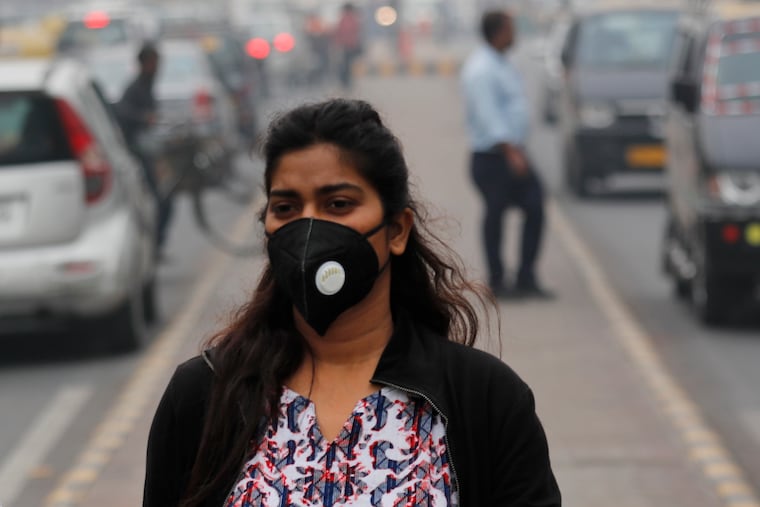How climate change affects us physically, emotionally and socially
Residents of New Delhi, India are battling a smog crisis, which for the past 2 weeks has endangered the respiratory health of millions. Last week, the government ordered schools closed for a second time as a result of severely poor air quality.

As a cold snap grips the Northeast, you are likely to reach for your coat, hat, and gloves before leaving the house in the morning. An anti-pollution mask with a 5-layer HEPA filter and built-in fan is typically not on your checklist.
This, however, is one of the items that residents of New Delhi, India need as they battle a smog crisis, which for the past 2 weeks has endangered the respiratory health of millions. Last week, the government ordered schools closed for a second time as a result of severely poor air quality. SAFAR, India’s pollution monitoring agency, advised everyone to close all their windows and avoid going outside. If people had to go outdoors, SAFAR recommended they wear N-95 or P-100 respirators. These are the kind of masks used on construction sites.
India is not alone in its struggle to breathe. According to the World Health Organization, nine out of 10 people worldwide are exposed to air containing high levels of pollutants. A staggering 7 million people die each year as a result of dangerous outdoor and household air quality. The statistics also hit close to home. Based on the 2018 American Lung Association’s “State of the Air” report, Philadelphia ranks as the 12th worst city in the country in terms of its year-round air pollution.
How we reached this environmental emergency is fairly clear. Climate scientists from around the world agree that greenhouse gases released by burning fossil fuels have made our planet warmer. Heat waves and stagnant air worsen air pollution, along with the industrial emissions themselves. The United Nations’ 2018 IPCC report on climate change concluded that global warming is likely to reach 1.5 degrees C between 2030 and 2052, impacting health, livelihoods, water supply, human security, and economic growth. Children, older adults, and other vulnerable populations will bear the brunt of it, especially those living in poverty.
The climate crisis does not just affect us physically, but emotionally and socially as well. It can disrupt our most basic sense of safety, taking away routines and choices that are critical for wellness. Where before, we might have taken for granted living in a hospitable environment, our relationship with nature seems more threatened than ever by anxiety and mistrust.
Emerging data supports the connection between climate change and increasing emotional distress. A 2018 study of 2 million people living in the U.S. found that exposure to more extreme weather was associated with worse mental health. A 1 degree C increase in temperature over five years coincided with a 2-percentage point increase in mental health issues.
Some studies have focused on specific weather events. Their results link depression and post-traumatic stress disorder symptoms to hurricanes and floods. The risk of suicide increases with heat waves and drought. Other consequences of climate change may include sleep disturbance, negative mood expressed on social media, and diminished cognitive performance among children. Experts also fear that social upheaval and intergroup conflict due to weather-related migration will further contribute to poor mental health outcomes.
In recent years, alarm over the earth’s vital signs has sounded throughout the world’s political, scientific, and medical communities. Political will and corporate change have not always followed. In fact, we have seen regression in the form of President Trump announcing his intentions of pulling out of the Paris Climate Accord, which would make the United States stand apart from nearly 200 other nations committed to reducing greenhouse gas emissions.
In spite of this looming policy barrier, there are steps that individuals, corporations, and countries can take to address climate change.
A study of the world’s largest and most environmentally friendly corporations, published this July, found that top-performers adopt proactive, detail-oriented strategies to improve sustainable practices, as opposed to simply managing risk. This pre-emptive stance includes exceeding regulatory standards, being vocal about their efforts to help the environment, and a willingness to devote resources to ease the consequences of global warming.
At a personal level, you should not underestimate the positive impact you could have by reducing your carbon footprint. According to 2017 data from the University of Oxford’s Global Change Lab, each person in the U.S. produces an average of 16 tons of CO2 a year. It takes approximately 229 trees to absorb that amount of carbon dioxide. Conservation.org offers a free carbon footprint calculator to spark ideas around lifestyle changes that could help offset these emissions. Areas include transportation, diet, and energy use.
Any action to support the environment can boost a sense of well-being and contribute to your carbon offset. The University of Michigan’s Center for Sustainable Systems offers some suggestions:
Eat local, vegetarian, or organic foods
Buy energy-efficient appliances, especially refrigerators, which are responsible for large amounts of energy consumption
Walk, bike, carpool, and use mass transit whenever possible
Turn off electronics when not in use
Recycle and buy products with minimal packaging
Environmental awareness, altruistic intent, and future-orientation are key. As French author Antoine de Saint Exupéry once wrote, “As for the future, it is not a question of foreseeing it, but of making it possible.”
Scott Glassman is a clinical assistant professor and associate director of the MS program in mental health counseling at Philadelphia College of Osteopathic Medicine.